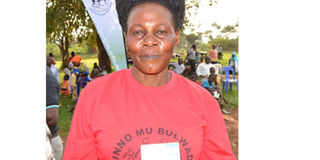Local health insurance scheme brings smile

Ms Robinah Nansikombi, a member of the Save for Health Insurance Scheme, shows off her biometric health insurance card at Kireku Village in Luweero District last Saturday. PHOTO BY DAN WANDERA
Luweero- When Ms Sarah Yawe, 44, a resident of Kamira Sub-county paid Shs30,000 as health insurance cover to benefit six members of her family in 2017, she was doubtful about the benefits of the health insurance cover since most of her family members were in good health for the first four months. In May, her mother was admitted to Kiwoko Hospital in Nakaseke District.
They had to move about 38kms from her home in Kamira Sub-county to the hospital. The hospital made a referral to a private hospital in Kampala because her mother’s condition had deteriorated and could not be handled by doctors at the facility.
The hospital authorities informed her that Save for Health Uganda, the scheme responsible for family insurance, would cover all the medical bills including those incurred at the hospital where she had been referred to in Kampala. The total bill was Shs250,000.
Her family could not have raised that money for medical bills, Yawe said during an interview with the Daily Monitor on Monday.
“I believe that sensitisation of the residents on the benefits of a health insurance scheme is very important because many still share the first opinion I held about losing the Shs30,000 in case we did not have any member of my family falling sick during the entire year. It is surprising that during that period, two other members of my family got medical treatment,” Ms Yawe whose family leaves at Kikondere Village, a distance of about 17kms from the nearest Health Centre II facility, a government facility that experiences frequent drug stock outs.
For Ms Robinah Nansikombi, 48, a resident of Kikyusa Sub-county and member of Munno Mu Bulwadde group, who is a member of the health insurance scheme, said it should be rolled out countrywide to lessen the long distances patients have to move to access health services.
“The long distances that members have to trek to access the medical services are a setback to many people who would want to subscribe to the community health insurance scheme. I personally have people who want to join the health insurance because they have seen how my family benefits, but demand an assurance from the health insurers to extend the services to the lower health units in their respective areas,” Ms Nansikombi says.
Speaking at the function where more than 300 residents received their respective annual health insurance membership cards for next year at Kamira Sub-county on December 14, several residents asked Luweero District leaders to implement the health insurance scheme which they claim could help perfect the health insurance system.
“We have been sensitised about the health insurance scheme that the district plans to roll out, but we are yet to get information on when the services will be rolled out,” Mr Joseph Kamya, a resident of Butuntumula Sub-county, said.
Last year, Luweero District Council approved an ordinance to have a community health scheme in place coordinated by Save for Health Uganda, a health partner currently implementing the project for members of Munno Mu Bulwadde group in Luweero, Nakaseke and Nakasongola districts.
Mr Ronald Ndawula, the Luweero District chairperson, says the community health insurance ordinance is before the office of the Solicitor General and would be implemented after clearance with responsible government departments.
“I urge residents to be patient as we wait for the government response. We plan to have the scheme affordable as one way of limiting on the out of pocket spending which is very stressing for many of our people,” Mr Ndawula says.
Mr Frederick Makaire, the executive director of Save for Health Uganda, says about 30,000 residents from Luweero, Nakasongola and Nakaseke districts are members of the community health insurance scheme.
“We have taken note of the requests by the residents including the demand to have the medical services offered at the nearby health units. Our challenge is still with the quality of services at some of the lower health units,” Mr Makaire says.



